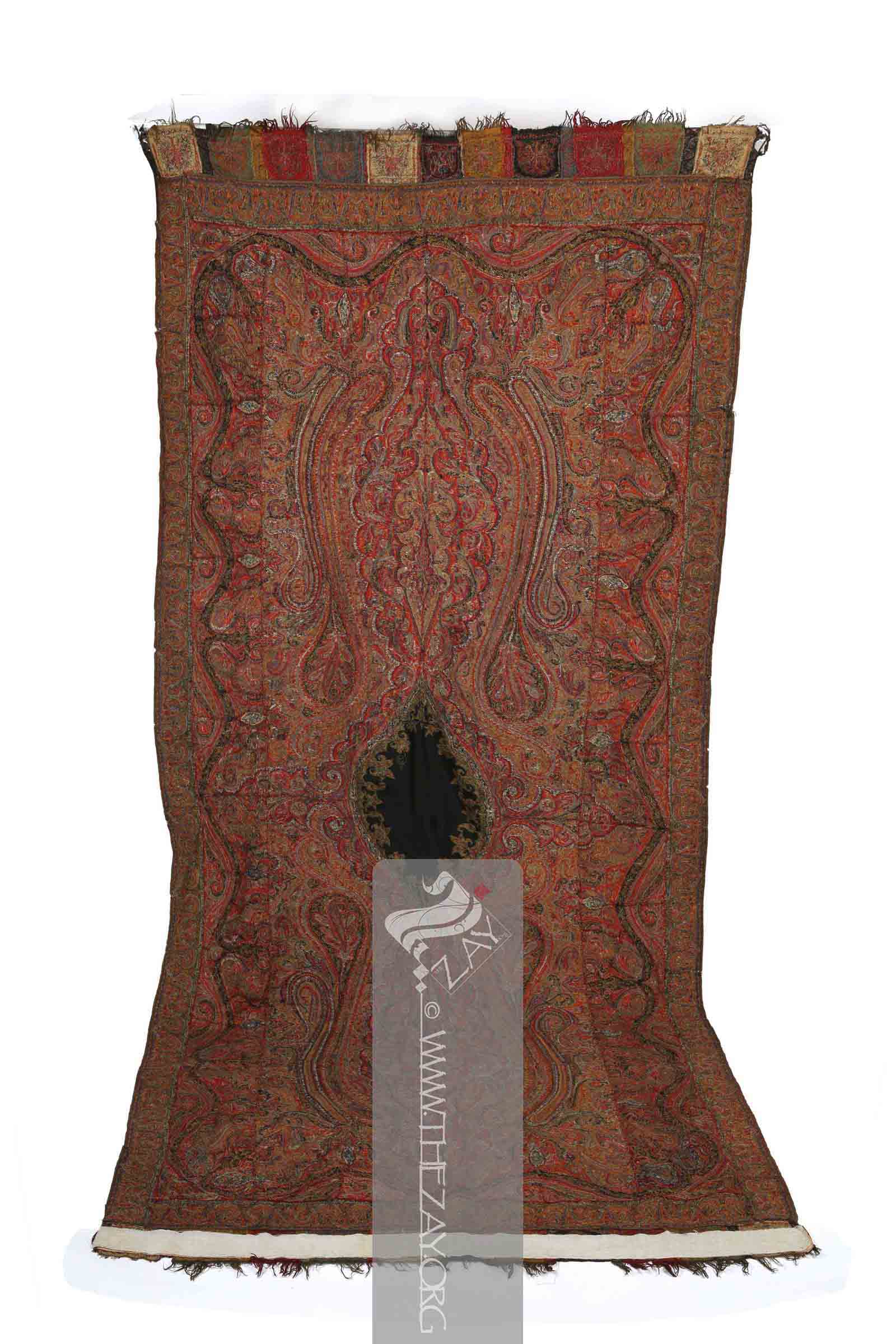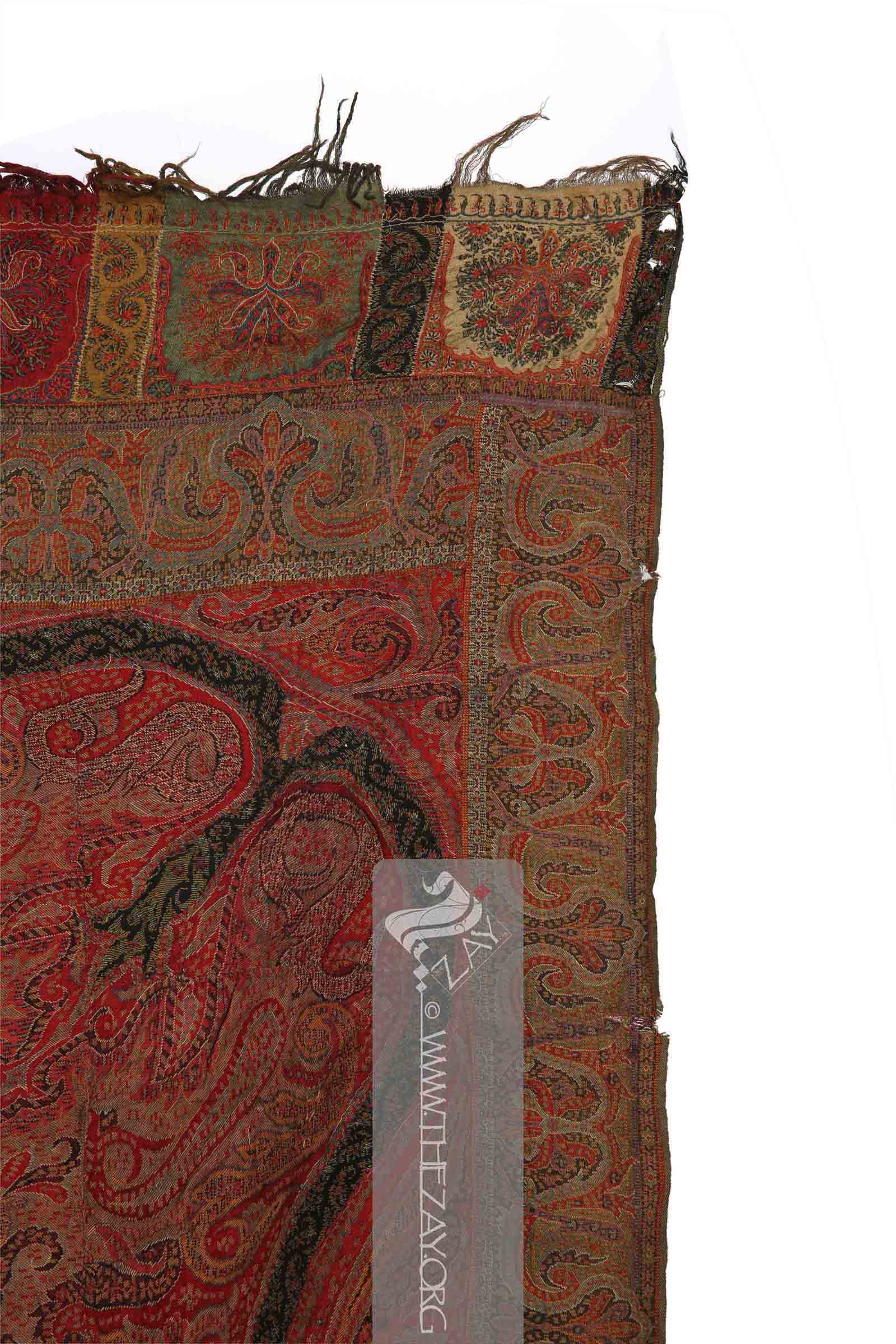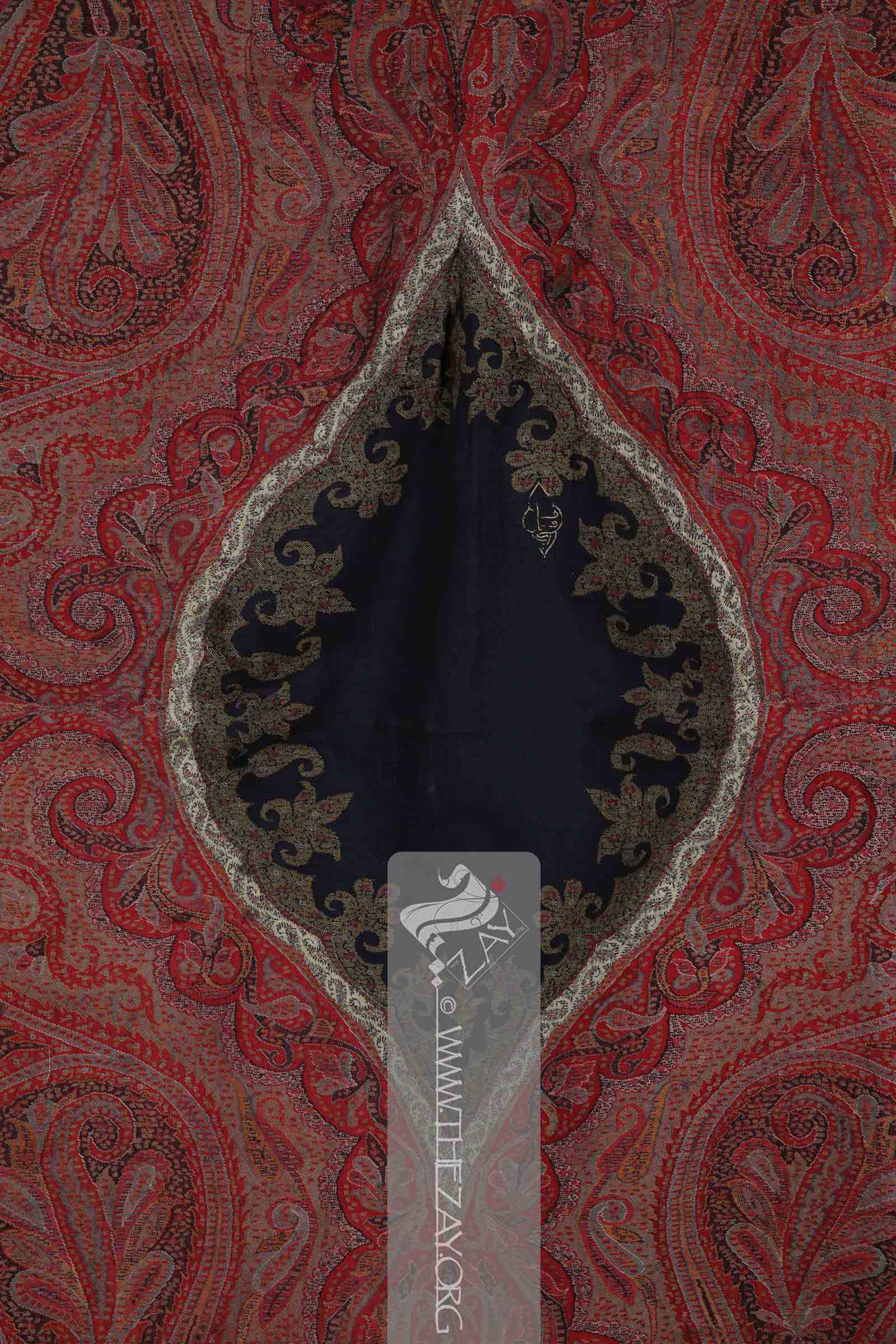








| Local Name | Kashmiri Kani Shawl |
| Object Category | Accessory |
| Gender | Unisex |
| Date of object | Circa1855 - 1865 |
| Place Of orgin | Asia |
| Region | Kashmir |
| Object Range | Afghanistan, India, Iran, Pakistan |
| Dimensions | Length: 306 cm Width: 147 cm |
| Materials | Wool |
| Technique | Hand Stitched Hand Embroidered Woven |
| Color | |
| Motif | Floral |
| Provenance | Purchased, Kerry Taylor Auctions, 2020 |
| Location | The Zay Zay: (Arabic: costume, Pl. azyaā’), a set of clothes in a style typical of a particular country or historical period. Initiative |
| Status | In storage |
| ZI number | ZI2020.500764 ASIA |
Object History
This Kashmiri
Kashmiri: (Hindustani: Kashmir – a region in South Asia), a term used to denote or identify anything related to the region – its people, their language, culture, art and craft, society etc. (twill_tapestry
Twill_tapestry: a weaving technique that creates diagonal patterns on a textile surface. Oldest archaeological remains of this type of weave dates back to 3000BCE in the Turfan province of China. Its application in other ancient civilizations such as the Incas are also well recorded. ) (Kani
Kani: (Kashmiri
Kashmiri: (Hindustani: Kashmir – a region in South Asia), a term used to denote or identify anything related to the region – its people, their language, culture, art and craft, society etc. : Small sticks, also a name of a village in Kashmir), a type of weave that originated in this village where wooden bobbins or sticks are used as spools on the loom to create intricate patterns instead of a shuttle.
Dr Joan Coleman began collecting shawls in 1976 and developed her lifelong passion for collecting. She was a regular at the London salesroom of Christie’s, Sotheby’s, and Phillips – three of the most outstanding auction houses of the period in the world – getting to know the dealers and learning in the process.
She acquired vast knowledge and dedicated hours carefully cataloguing her ever-growing collection. She intended to loan her collection to different museums and institutions for the benefit of learning and education.
Her collection is one of the largest and the finest private shawl Shawl: (Persian: shāl from Hindi: duśālā – Shoulder Mantle), a shawl is a South Asian version of a scarf worn or wrapped loosely over the shoulders and is usually made of wool. collections to have ever graced the world, with shawls from Kashmir, Paisley Paisley: (Scottish Gaelic, Pàislig: a town in Scotland), often called buta, boteh, amli, or kalgi in the subcontinent and kazuwah in Arabic, is a Persian tear drop motif with a curved end specially in textiles. Its popularity and subsequent local production in 18th century at Paisley are responsible for its nomenclature., Edinburgh, Norwich, France, and Iran.
Object Features
This rectangular shawl
Shawl: (Persian: shāl from Hindi: duśālā – Shoulder Mantle), a shawl is a South Asian version of a scarf worn or wrapped loosely over the shoulders and is usually made of wool. is composed of several patches of polychrome woollen fabric on a red (madder
Madder: (Latin: Rubia tinctorum – Eurasian herb), rose madder, common madder or dyer's madder is a vegetable dye made from the roots of a perennial plant belonging to the bedstraw and coffee family. It has been used extensively as a vegetable red dye across the globe from India to England.
It has a large black oblong medallion in a trellis pattern in the middle with an ivory border with floral patterns sprouting inside. The signature of the manufacturer is embroidered in silk thread (resham Rīsham: (Persian: abrīšam – silk yarn), referring to silk threads in the Indian subcontinent and Iran. ) in a corner of the central black panel.
The medallion is surrounded by four large paisley Paisley: (Scottish Gaelic, Pàislig: a town in Scotland), often called buta, boteh, amli, or kalgi in the subcontinent and kazuwah in Arabic, is a Persian tear drop motif with a curved end specially in textiles. Its popularity and subsequent local production in 18th century at Paisley are responsible for its nomenclature. motifs mirroring one another with smaller oblong trellis patterns in ivory running along the inner border of the design.
The two borders on the longitudinal sides of the fabric are decorated with floral patterned arches, with a central bouquet, that gives way to fringes at the end. With multiple colours and motifs, this piece is a typical example of a Kani
Kani: (Kashmiri
Kashmiri: (Hindustani: Kashmir – a region in South Asia), a term used to denote or identify anything related to the region – its people, their language, culture, art and craft, society etc. : Small sticks, also a name of a village in Kashmir), a type of weave that originated in this village where wooden bobbins or sticks are used as spools on the loom to create intricate patterns instead of a shuttle.
Usually, a Kashmiri
Kashmiri: (Hindustani: Kashmir – a region in South Asia), a term used to denote or identify anything related to the region – its people, their language, culture, art and craft, society etc. shawl
Shawl: (Persian: shāl from Hindi: duśālā – Shoulder Mantle), a shawl is a South Asian version of a scarf worn or wrapped loosely over the shoulders and is usually made of wool. is woven in a twill
Twill: (English), one of the three primary textile weaves is defined by its prominent diagonal rib pattern. The fabrics woven in this method typically exhibit a pronounced, often darker front side, while the back is lighter.
In the early 19th century, with the introduction of more elaborate designs, a new practice of dividing the work of a single shawl Shawl: (Persian: shāl from Hindi: duśālā – Shoulder Mantle), a shawl is a South Asian version of a scarf worn or wrapped loosely over the shoulders and is usually made of wool. across multiple looms was introduced, making production time shorter.
Each loom would weave a part of the same shawl
Shawl: (Persian: shāl from Hindi: duśālā – Shoulder Mantle), a shawl is a South Asian version of a scarf worn or wrapped loosely over the shoulders and is usually made of wool. , then it would be handed over to the needleworker or darner (rafugar
Rafugar: (Hindi/Urdu: Rafu meaning darning), a term commonly used in the Indian subcontinent collectively refers to darners, fixers, hand embroiderers, and other needleworkers.
The use of turquoise
Turquoise: (French: turquois – present day Türkiye; Synonyms: firuze, pheroza), is a naturally occurring opaque mineral mined in abundance in Khorasan province of Iran and has been used for making dye for centuries. The term is a derivative of the French word for the country Türkiye once called Turkey. (pheroza
Pheroza: (Persian: pērōzah – "victory", later Arabic: fayrūz; Synonyms: firuze, turquoise
Turquoise: (French: turquois – present day Türkiye; Synonyms: firuze, pheroza), is a naturally occurring opaque mineral mined in abundance in Khorasan province of Iran and has been used for making dye for centuries. The term is a derivative of the French word for the country Türkiye once called Turkey. ), is a naturally occurring opaque mineral mined in abundance in Khorasan province of Iran and has been used for making dye for centuries. ), black, and ivory with shades of red on a madder
Madder: (Latin: Rubia tinctorum – Eurasian herb), rose madder, common madder or dyer's madder is a vegetable dye made from the roots of a perennial plant belonging to the bedstraw and coffee family. It has been used extensively as a vegetable red dye across the globe from India to England.
The larger part of the fabric is decorated with four large leaves sprouting from the inner corners and paisleys of different variations forming the inner layer (tanjir Tanjīr: (Possibly Persian: zanjir: Chain), a narrow layer of pattern that forms the border and runs above and below the wider layer. ) of the border. The outermost layer (phala Phāla: (Etymological origin: Possibly Indo Persian), the wider layer of pattern that forms the border at each warp Warp: One of the two basic components used in weaving which transforms thread or yarns to a piece of fabric. The warp is the set of yarns stretched longitudinally in place on a loom before the weft Weft: one of the two basic components used in weaving that transforms thread or yarns into a piece of fabric. It is the crosswise thread on a loom that is passed over and under the warp threads. is introduced during the weaving process. end or head of a shawl Shawl: (Persian: shāl from Hindi: duśālā – Shoulder Mantle), a shawl is a South Asian version of a scarf worn or wrapped loosely over the shoulders and is usually made of wool. . ) of the border resembles the floral-patterned decorative arches of (Indo_Persian architecture Indo_Persian Architecture: A style of architecture originating in the Indian subcontinent after the introduction of Islam through Central Asia and Persia. Drawing from both Hindu and Islamic architectural styles with domes and arches as common features although different styles due to the materials used for their respective constructions.) each with a central bouquet resembling a cyprus tree. The fringes hanging on the shorter ends of the fabric are the warp Warp: One of the two basic components used in weaving which transforms thread or yarns to a piece of fabric. The warp is the set of yarns stretched longitudinally in place on a loom before the weft Weft: one of the two basic components used in weaving that transforms thread or yarns into a piece of fabric. It is the crosswise thread on a loom that is passed over and under the warp threads. is introduced during the weaving process. threads in their original colour and act as decorative trimmings.
The signature of the manufacturer along with touches of embroidery throughout the fabric are embroidered in resham Rīsham: (Persian: abrīšam – silk yarn), referring to silk threads in the Indian subcontinent and Iran. .
Links: